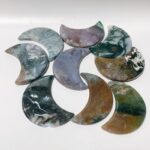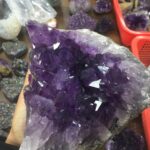Introduction

Quartz is the most common rock-forming mineral on Earth, comprising over 12% of the Earth’s crust. It is a versatile material with a wide range of applications, including in electronics, jewelry, and construction.
Occurrence of Quartz
Primary Sources
Quartz forms in a variety of geological settings, primarily as a primary mineral in igneous and metamorphic rocks.
-
Igneous Rocks: Quartz is present in many igneous rocks, including granite, pegmatite, and volcanic rocks. In granite, quartz is typically found as a coarse-grained component, while in volcanic rocks it forms fine-grained crystals.
-
Metamorphic Rocks: Quartz is also common in metamorphic rocks, such as quartzite, marble, and gneiss. Quartzite is almost entirely composed of quartz, while marble contains significant amounts of quartz along with calcite.
Secondary Sources
In addition to its occurrence in primary sources, quartz can also be found in secondary deposits, such as:
-
Veins and Pegmatites: Quartz often fills veins and cavities in rocks. Pegmatites are coarse-grained igneous rocks that form from the crystallization of a magma’s residual fluids. They often contain large crystals of quartz.
-
Hydrothermal Deposits: Quartz can be deposited as a result of hydrothermal fluids flowing through rocks. These deposits typically form in association with volcanic activity and can contain valuable minerals, such as gold and silver.
-
Sand and Gravel: Quartz is a common component of sand and gravel deposits. These deposits are formed by the weathering and erosion of rocks containing quartz.
Global Distribution
Quartz is found in all parts of the world, but some regions have particularly abundant deposits:
-
United States: The United States has significant quartz deposits in the western and southeastern states. The Black Hills of South Dakota and the Ouachita Mountains of Arkansas are known for their large pegmatite deposits containing quartz.
-
Brazil: Brazil is the world’s leading producer of quartz. The country has vast deposits of quartzite in the Amazon basin and central region.
-
China: China is another major producer of quartz. The country has large deposits of quartz in the eastern and western provinces.
-
India: India has significant quartz deposits in the northern and central parts of the country. Rajasthan and Madhya Pradesh are important producers of quartz.
Uses of Quartz
Quartz has a wide range of industrial, electronic, and decorative applications:
Electronics: Due to its piezoelectric properties, quartz is used in electronic devices such as oscillators, watches, and filters. Quartz crystals can generate an electrical charge when pressure is applied, and they are also used in the production of semiconductors.
Jewelry: Quartz is a popular gemstone for jewelry because of its beauty and durability. Clear quartz is known as rock crystal and is often used in jewelry. Other varieties of quartz, such as amethyst, citrine, and rose quartz, are also popular gemstones.
Construction: Quartz is used as an aggregate in construction materials such as concrete, asphalt, and mortar. It is also used as a decorative material in countertops, tiles, and flooring.
Other Applications: Quartz is also used in a variety of other applications, including:
-
Optical Lenses: Quartz is used to make high-quality lenses for optical instruments such as telescopes and microscopes.
-
Abrasives: Quartz is a hard mineral that is used as an abrasive in products such as sandpaper and polishing compounds.
-
Ceramics: Quartz is used as a raw material in the production of ceramics, such as porcelain and stoneware.
Quartzite: A Durable and Ornamental Stone
Quartzite is a metamorphic rock almost entirely composed of quartz. It is a hard, durable material that is often used in construction and landscaping applications.
Properties of Quartzite:
-
Durability: Quartzite is highly resistant to wear and tear, making it an ideal material for high-traffic areas and outdoor applications.
-
Heat Resistance: Quartzite can withstand high temperatures, making it a suitable choice for fireplaces, fire pits, and outdoor grills.
-
Chemical Resistance: Quartzite is resistant to most chemicals and acids, which makes it a good choice for countertops and other surfaces that may come into contact with harsh substances.
Applications of Quartzite:
Quartzite is used in a variety of architectural and landscaping applications, including:
-
Countertops: Quartzite makes a durable and aesthetically pleasing countertop option for kitchens and bathrooms.
-
Tiles: Quartzite tiles are suitable for both indoor and outdoor applications, including floors, walls, and patios.
-
Landscaping: Quartzite is often used in landscaping to create pathways, patios, and retaining walls.
-
Other Applications: Quartzite can also be used for decorative purposes in furniture, sculptures, and other objects.
Amethyst: A Popular Gemstone
Amethyst is a variety of quartz that has a purple color. It is one of the most popular gemstones in the world and is often used in jewelry and other decorative applications.
Properties of Amethyst:
-
Color: Amethyst is typically a deep purple color, but it can also range from light lavender to almost black. The color is caused by the presence of iron impurities in the quartz crystal.
-
Transparency: Amethyst is usually transparent or translucent, allowing light to pass through it.
-
Durability: Amethyst is a relatively hard mineral, but it can be scratched by harder materials, such as diamonds.
Applications of Amethyst:
Amethyst is primarily used in jewelry, but it also has a number of other applications, including:
-
Healing Properties: Amethyst is believed to have healing properties, such as reducing stress and anxiety, promoting sleep, and boosting the immune system.
-
Metaphysical Properties: Amethyst is said to have metaphysical properties, such as promoting spiritual growth, enhancing psychic abilities, and protecting against negative energy.
Citrine: A Bright Yellow Gemstone
Citrine is a variety of quartz that has a yellow color. It is often mistaken for topaz, but citrine is a more affordable and readily available gemstone.
Properties of Citrine:
-
Color: Citrine typically has a bright yellow color, ranging from pale yellow to golden yellow. It is sometimes referred to as “the yellow topaz” because of its resemblance to topaz.
-
Transparency: Citrine is usually transparent or translucent, allowing light to pass through it.
-
Durability: Citrine is a relatively hard mineral, but it can be scratched by harder materials, such as diamonds.
Applications of Citrine:
Citrine is primarily used in jewelry, but it also has a number of other applications, including:
-
Healing Properties: Citrine is believed to have healing properties, such as boosting the immune system, promoting digestion, and reducing fatigue.
-
Metaphysical Properties: Citrine is said to have metaphysical properties, such as promoting optimism, creativity, and self-confidence.
Rose Quartz: A Pink Gemstone of Love
Rose quartz is a variety of quartz that has a pink color. It is often associated with love and is a popular gemstone for jewelry and other decorative applications.
Properties of Rose Quartz:
-
Color: Rose quartz typically has a soft pink color, ranging from pale pink to deep rose pink. The color is caused by the presence of titanium impurities in the quartz crystal.
-
Transparency: Rose quartz is usually translucent, allowing light to pass through it.
-
Durability: Rose quartz is a relatively hard mineral, but it can be scratched by harder materials, such as diamonds.
Applications of Rose Quartz:
Rose quartz is primarily used in jewelry, but it also has a number of other applications, including:
-
Healing Properties: Rose quartz is believed to have healing properties, such as promoting emotional healing, reducing stress, and increasing self-esteem.
-
Metaphysical Properties: Rose quartz is said to have metaphysical properties, such as attracting love, fostering relationships, and promoting peace and harmony.
Conclusion
Quartz is a versatile and abundant mineral that is used in a wide range of applications. It is found in both primary and secondary sources worldwide, and its unique properties make it a valuable material for a variety of industries. Whether used in electronics, jewelry, construction, or decorative applications, quartz continues to play an important role in human society.




























